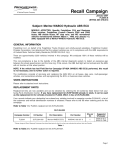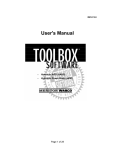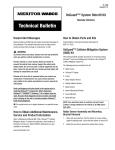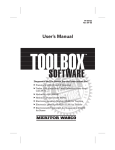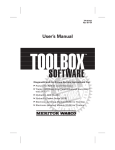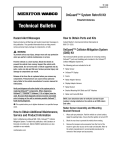Download TECHNICAL BULLETIN
Transcript
TP-96139 Revised 02-00 TECHNICAL BULLETIN This technical bulletin covers both cab and chassis leveling valves manufactured by Meritor WABCO. While the general installation and maintenance information applies to both valves, there are some differences. A cab or chassis valve icon appears wherever this occurs. Meritor WABCO Cab Leveling Valves and Chassis Leveling Valves Figure 1 SUPPLY CONTROL LEVER IN OUT Indicates Information Applies to Cab Leveling Valve. Indicated Information Applies to Chassis Leveling Valve. DELIVERY LEVELING VALVE VERTICAL LINKAGE How the Cab Leveling and Chassis Leveling Valves Work The positions illustrated are for chassis leveling valves. In cab leveling valve applications, the UP/DOWN control lever movements for supply/exhaust may be reversed, depending upon the mounting location. When Vehicle Load Is Increased Figure 2 AIR INLET TO AIR BAGS • The control lever shifts to allow air from the reservoir to flow through the supply port and into the air bags from the delivery port. Figure 1 and Figure 2. • Pressure in the air bags increases and raises the chassis or cab height. When the operating valve reaches NEUTRAL position, the valve closes. TO AIR BAGS LEVELING VALVE CONTROL LEVER EXHAUST PORT VERTICAL LINKAGE 16579/24240 Printed in the USA © Copyright Meritor WABCO , 2000 TP-96139 Revised 02-00 Page 1 When Vehicle Load Is Decreased CAB LEVELING VALVE Pull the control lever UP 1.0 - 1.5 inches (25-38 mm). If air passes through the valve, the intake section of the valve works correctly. The cab will rise and the flow of air will be audible. Figure 3. • The control lever shifts in the opposite direction and allows air to exhaust from the air bags through the valve or delivery/exhaust ports. Check Valves • A check valve in the chassis leveling valve maintains air pressure in the suspension system even if, for example, air bag pressure exceeds supply pressure or a blockage exists in the delivery system. CHASSIS LEVELING VALVE Pull the control lever UP at a 45° angle. If air passes through the valve, the intake section of the valve works correctly. The chassis will rise and the flow of air will be audible. Figure 4. • A check valve in the cab leveling valve retains minimum air bag inflation pressure. Checking the Cab or Chassis Leveling Valve Figure 3 WARNING To prevent serious eye injury, always wear safe eye protection when you perform vehicle maintenance or service. CONTROL LEVER 1 IN 2 OUT Park the vehicle on a level surface. Block the wheels to prevent the vehicle from moving. Support the vehicle with safety stands. Do not work under a vehicle supported only by jacks. Jacks can slip and fall over. Serious personal injury can result. Verify that all personnel are clear of the tractor before you inflate or deflate the air bags. The air suspension has various pinch points that can cause serious personal injury. 3 LEVELING VALVE VERTICAL LINKAGE CLAMPS VERTICAL LINKAGE 1. INFLATE 2. NEUTRAL POSITION 3. DEFLATE Figure 4 1. Unhitch the trailer from the tractor. 2. Block the wheels. 3. Run the engine to build up vehicle air pressure to at least 100 psi (690 kPa) to ensure the pressure protection valve does not block supply to the leveling valve. NEUTRAL POSITION CONTROL LEVER INFLATE 45˚ 4. Disconnect the leveling valve linkage from the control lever. NOTE: Meritor WABCO cab and chassis leveling valves are not serviceable. VERTICAL LINKAGE -45˚ DEFLATE LEVELING VALVE 5. Move the control lever: NOTE: In some cab applications, the UP/DOWN control lever movements for supply/exhaust may be reversed. NOTE: Cab leveling valves exhaust internally at the boot opening and body seams, and can be heard when you enter and exit the vehicle. TP-96139 Revised 02-00 Page 2 © Copyright Meritor WABCO , 2000 16579/24240 Printed in the USA The NEUTRAL position (see Figure 3 and Figure 4) is an area in which the cab or chassis leveling valve is neither supplying nor exhausting air. It can also be referred to as the “dead band.” The NEUTRAL position on a chassis leveling valve with an 8 inch (203 mm) control lever is typically ± 1/4 inch (6.3 mm), but can range between a minimum ± 1/8 inch and a maximum ± 3/8 inch (3.2 mm and 9.5 mm) on most vehicles. On a normal cab leveling valve installation, the NEUTRAL position will respond similarly, but will be very narrow: ± 1/16 inch (1.5 mm). 6. Return the control lever to the NEUTRAL position. Air should stop flowing. 7. Move the control lever: 12. If the valve operates correctly as outlined in all of the above steps, no further checking of the valve is necessary. However, the valve linkage may be out of adjustment or another condition may exist. Do not replace the leveling valve. Reconnect the leveling valve vertical linkage to the control lever. Refer to the leveling valve adjustment procedures in this publication. Adjusting the Chassis Leveling Valve WARNING Remove all air from the system before you service any air system component. Pressurized air can cause serious personal injury. CAB LEVELING VALVE Push the control lever DOWN 1.0 - 1.5 inches (25-38 mm). If air exhausts through the valve, the exhaust section of the valve is operating correctly. The cab will lower and the flow of air will be audible. 1. Unhitch the trailer from the tractor. Do not apply the parking brakes. Block the wheels on one axle only. With the vehicle on a level surface, adjust the suspension height. Verify that there is no load on the chassis. CHASSIS LEVELING VALVE Push the control lever DOWN at a 45° angle. If air exhausts through the valve, the exhaust section of the valve is operating correctly. The chassis will lower and the flow of air will be audible. 3. Mark the location of the front and rear tires on the floor. 8. If the leveling valve does not supply or exhaust air, or if the NEUTRAL position will not stop the flow of air, refer to the Diagnostics Chart on page 7. Eliminate all possible diagnostic causes before replacing the leveling valve. 9. Return the control lever to the NEUTRAL position. Install a 5/32 inch (4 mm) pin or drill bit into the valve body to secure the control arm in the NEUTRAL position. If the air stops, the valve is working correctly. If the air does not stop, refer to the Diagnostics Chart on page 7 before replacing the valve. 2. With the transmission in NEUTRAL, build the secondary air pressure to at least 100 psi (690 kPa). Turn the engine OFF. 4. Verify that the control lever is installed in the correct cross hole as indicated by the mark (<) on the boss. Figure 5. Figure 5 PIVOT POINTS 8 INCHES (203 MM) MOUNTING FASTENERS ADJUSTMENT LOCKNUT 1 10. Remove the 5/32 inch (4 mm) pin or drill bit from the valve body. 11. Check the NEUTRAL position to ensure a minimum ± 1/8 inch (3.2 mm) and a maximum ± 3/8 inch (9.5 mm). If the NEUTRAL position band exceeds either range, replace the leveling valve. Consult the manufacturer's service manual for correct removal and installation procedures. 16579/24240 Printed in the USA CONTROL LEVER VERTICAL LINKAGE 2 1. The marking on the boss must be pointing toward the front of the vehicle. 2. Install 5/32 inch (4 mm) pin or drill bit here to secure in the NEUTRAL position. © Copyright Meritor WABCO , 2000 TP-96139 Revised 02-00 Page 3 5. Check the length of the control lever between pivot points. The length should be 8 inches (203 mm). If adjustment of the length of the control lever is required, proceed to Step 6. If the length of the control lever is correct, proceed to Step 9. Figure 7 CONTROL LEVER REAR AXLE HOUSING 6. Loosen the adjustment locknut on the chassis leveling valve. MOUNTING BRACKET 7. Move the control lever FORWARD or BACKWARD until the length between the pivot points is 8 inches (203 mm). VERTICAL LINKAGE 8. Tighten the adjustment locknut to a torque of 62 lb-in (700 N•cm). If height adjustment is needed, use 2-1/2 inches (64 mm) as the target value. 9. Measure the distance from the bottom of the most forward left axle stop to the top of the axle U-bolt pad. Figure 6. The correct distance is 2-3/8 - 2-7/8 inches (60-73 mm). If the distance is within this specification, the leveling valve is installed correctly. AIR BAG 13. Push the control lever DOWN to let the air exhaust from the valve until the distance from the bottom of the axle stop to the top of the axle U-bolt pad is 2 inches (51 mm) or less. NOTE: Whenever you adjust the valve, exhaust the air springs and raise the chassis to the recommended measurement. Figure 6 LEFT MOST FORWARD AXLE STOP 14. Rotate the leveling valve LEFT-TO-RIGHT to raise the suspension height to 2-1/2 inches (64 mm). Stop the air flow to the air bag by rotating the leveling valve RIGHT-TO-LEFT to the “dead” band. 1 15. Rotate the leveling valve so it is in the center of the NEUTRAL position. U-BOLT PAD 16. Insert a 5/32 inch (4 mm) drill bit or pin through the hole in the lower right side of the metal flange and into the valve body to secure the valve in neutral. Figure 5. 1. Measure height here (2-3/8 - 2-7/8 inches [60-73 mm]). 17. Tighten the height control valve mounting fasteners. Refer to the vehicle manufacturer's service manual for correct torque specifications. 18. Remove the 5/32 inch (4 mm) drill bit or pin. 10. If the distance is not correct, go to Step 11. If the distance is correct, apply the parking brakes. Remove the blocks from the wheels. 11. Loosen the two mounting fasteners that attach the leveling valve to the mounting bracket. NOTE: Rotate the leveling valve slightly to prevent changing the suspension height. 12. Rotate the leveling valve RIGHT-TO-LEFT (as you are facing it from the driver’s side of the vehicle) to lower the suspension height to 2-1/2 inches (64 mm). Figure 7. TP-96139 Revised 02-00 Page 4 19. Test drive the unloaded vehicle for about 1/4 mile (1/2 km). 20. To ensure accurate measurements, return the vehicle to the exact location as previously marked on the floor in Step 3. Park the vehicle using a light brake application. 21. Block the wheels on one axle only. Put the transmission into neutral. Do not apply the parking brakes. © Copyright Meritor WABCO , 2000 16579/24240 Printed in the USA NOTE: During the test drive, it is normal for the vehicle to adjust for the width of the NEUTRAL position. The measurement made after the test drive will be slightly larger than that which was originally set. If the height is within the specified limits, do not readjust. 22. Remeasure the distance between the bottom of the most forward left axle stop and the top of the axle U-bolt pad. Figure 6. If the distance is incorrect, repeat the adjustment procedure. 23. If the distance is correct, the adjustment procedure is complete. Apply the parking brakes and then remove the blocks from the wheels. Adjusting the Cab Leveling Valve 1. With the vehicle on a level surface, adjust the cab height. Make sure there is no load on the cab. Apply the parking brakes. Block the wheels. 2. With the transmission in NEUTRAL, build the secondary air pressure to at least 100 psi (690 kPa). Turn the engine OFF. NOTE: If height adjustment is needed, use 1.0 inch (25 mm) as the target value. 4. If the distance is correct, remove the blocks from the wheels. If the distance is not correct, go to Step 5. 5. Put a one-inch (25 mm) block between the UPPER and LOWER cab-mount stops. If necessary, raise the cab so the block will fit, then lower the cab onto the block. 6. Disconnect the control lever from the vertical linkage. 7. Pull back the flap on the rubber boot to expose the hole in the cab leveling valve body. Figure 9. Move the control lever UP or DOWN slightly to align the hole in the valve body with the hole in the plastic pivot assembly. Figure 9 1 BOOT FLAP CONTROL LEVER NOTE: If the rubber cap is missing from the lower cab-mount stop, replace it before measuring the cab height. 3. Measure the distance from the bottom of the upper cab-mount stop to the top of the lower cab-mount stop. Figure 8. The correct distance is 7/8 - 1-1/4 inches (22-32 mm). If the distance is within this specification, the cab leveling valve is installed correctly. RUBBER BOOT 1. Install 5/32 inch (4 mm) pin or drill bit here to secure the NEUTRAL position. Figure 8 AIR BAG UPPER CAB-MOUNT STOP SHOCK ABSORBER CAB LEVELING VALVE AIR BAG 1 SHOCK ABSORBER VERTICAL LINKAGE RUBBER CAP LOWER CAB-MOUNT STOP CONTROL LEVER 1. Measure height here (7/8 - 1-1/4 inches [22-32 mm]). 16579/24240 Printed in the USA © Copyright Meritor WABCO , 2000 TP-96139 Revised 02-00 Page 5 8. Insert a 5/32 inch (4 mm) pin or drill bit into the holes to secure the cab leveling valve in the NEUTRAL position. 9. Adjust the length of the vertical linkage. Lengthen or shorten the vertical linkage rod as necessary until the upper hole in the linkage aligns with the hole in the control lever. Retighten the linkage clamps. 10. Connect the vertical linkage to the control lever. Tighten the fasteners. Refer to the vehicle manufacturer’s service manual for correct torque specifications. 11. Remove the 5/32 inch (4 mm) pin or drill bit previously inserted in the leveling valve. 12. Raise the control lever to its maximum height to allow the air bags to inflate. Hold the control lever up until the weight of the cab is off the block. Remove the block. 13. To confirm the adjustment, push DOWN on the control lever. Hold the lever down until most of the air is exhausted from the air bags. 14. Release the control lever and let the valve return to the NEUTRAL position. Measure the distance between the upper and lower cab-mount stops. The distance should be between 7/8 - 1-1/4 inches (22-32 mm). If the distance is incorrect, repeat the adjustment procedure. 15. If needed, minor adjustments should be made to the vertical linkage to ensure that the vertical linkage is perpendicular to the control lever. 16. Remove the blocks from the wheels. Removal and Installation of Leveling Valve Consult the vehicle manufacturer’s service manual for correct installation and removal procedures. TP-96139 Revised 02-00 Page 6 © Copyright Meritor WABCO , 2000 16579/24240 Printed in the USA Diagnostics Chart CONDITION POSSIBLE CAUSE CORRECTIVE ACTION NO AIR TO THE VALVE • Air system not working properly Inspect air lines for pinching. Inspect pressure protection valve. Verify system pressure by removing the supply line at the valve. Inspect the internal valve filters for debris. Remove debris as necessary. Refer to the OEM operating instructions for pressure protection valve information. • Clogged air supply lines • Clogged valve filter EXHAUSTING OF AIR AFTER CONTROL LEVER REVERTS TO NEUTRAL POSITION HIGH AIR CONSUMPTION ROUGH RIDE BOTTOMING OUT VIBRATION 16579/24240 Printed in the USA • Audible supplying and/or exhausting of air that stops after the vehicle adjusts ride height Normal operation of valve exhaust. No action required. Changes to the cab or chassis height require the valve to supply or exhaust air from the system. The cab leveling valve can frequently be heard during and just after entry or exiting of the cab. • Contaminants in the air system Inspect the air supply system for oil, moisture or foreign materials. If contamination is suspected, evacuate and clean the system. Reassemble and test the leveling valve for proper operation. Replace only if the valve testing procedures fail. • Stripped or damaged fittings or perforated air lines Inspect all air supply lines and fittings for possible leaks. Damage may occur to fittings during installation or transportation. Replace as necessary. • Incorrect tubing installation Particularly on the cab leveling valve, inspect tubing cuts and connections. Re-cut and reassemble as necessary. Make sure cuts are straight and smooth. Use the proper tube cutting tool. • Improper plumbing Inspect installation of the inlet and output ports. Reassemble as instructed in the manufacturer's service manual. [Note: The cab valve will maintain ride height if the inlet and outlet lines are reversed, but the valve will continuously exhaust at ride height.] • Control lever length is incorrect Refer to the valve adjustment procedures for proper installation. • Internal problem with leveling valve If all of the above causes have been eliminated and the problem still persists, contact the Meritor WABCO Customer Service Center at 800-535-5560. • Air leakage Check all air lines and connections for leaks. Make necessary repairs. • Worn shock absorbers on either the cab or chassis Check shocks for oil leakage. Replace shocks as necessary. Worn shocks result in excess cab or chassis movement. • Control lever length is incorrect Follow the linkage and valve adjustment procedures on pages 3 and 5 to adjust linkage to OEM specifications. • Incorrect valve installation Follow the linkage and valve adjustment procedures on pages 3 and 5. Check for proper valve installation and orientation of plumbing to the air supply and delivery ports. If problem persists, contact Meritor WABCO Customer Service Center at 800-535-5560. • Adjust the control lever to specifications. NEUTRAL position below minimum • Incorrect ride height Check the height at the proper measuring points. Adjust the cab leveling valve as necessary. (Refer to Adjusting the Leveling Valve on page 5). • Worn shock absorbers Check shocks for oil leakage. Worn shocks result in excess cab or chassis movement. • Valve will not exhaust Check for crimped air delivery line or incorrect installation of control lever. Make necessary repairs. • Wide NEUTRAL position Follow the linkage and valve replacement procedures. • Valve will not deliver air Check for crimped air supply and/or delivery lines. Verify system pressure at the valve. Check for proper valve installation. Check for blockage in the dump valve. • Incorrect chassis height Check the chassis height at the proper measuring points. Adjust the chassis leveling valve as necessary. (Refer to page 3.) • Worn shock absorbers Check shocks for oil leakage. Worn shocks result in excess cab or chassis movement. • Wide NEUTRAL position Follow the linkage and valve replacement procedures. • Incorrect drive line angles Follow the linkage and valve adjustment procedure on page 3 and page 5. © Copyright Meritor WABCO , 2000 TP-96139 Revised 02-00 Page 7 Meritor WABCO Vehicle Control Systems 3331 West Big Beaver Road, Suite 300 Troy, MI 48084 USA 800-535-5560 www.meritorauto.com Information contained in this publication was in effect at the time the publication was approved for printing and is subject to change without notice or liability. Meritor WABCO reserves the right to revise the information presented or discontinue the production of parts described at any time. © Copyright 2000 Meritor WABCO All Rights Reserved Printed in the USA TP-96139 Issued 02-00 16579/24240















